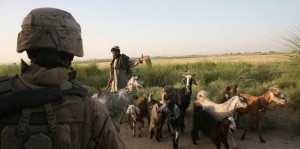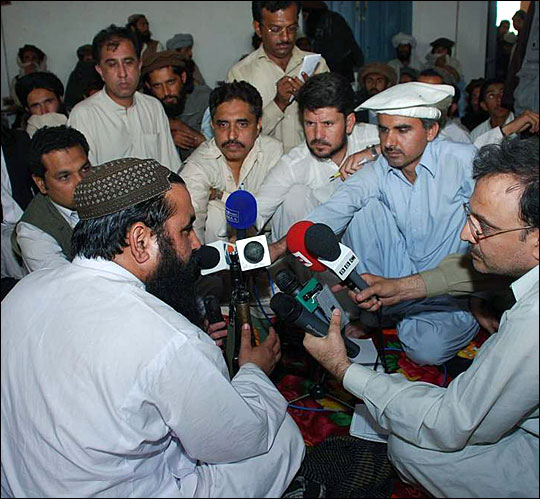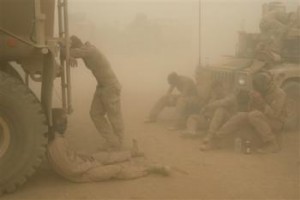Des Browne Continues the British Surrender
BY Herschel SmithWe covered the surrender plea from David Miliband, and while pusillanimous and pitiful, at least Miliband was either duplicitous or didn’t know what he was talking about. Specifically, he advocated “negotiations between Pakistan’s new civilian government and Pashtun leaders in the Federally Administered Tribal Areas (Fata).”
If he was referring to tribal elders in FATA, then he was merely confused, as there are no negotiations with “Pashtun leaders.” Further, they would be irrelevant if these talks existed, as the tribal elders do not control FATA. They have no security from the Taliban, and thus hard core Taliban fighters control FATA and NWFP. If he is referring to the Taliban as “Pashtun leaders,” then he is intentionally avoiding naming the enemy and stating that we should negotiate with them. He is either stupid or a liar.
As for Des Browne, no such charge can be made. He is a coward and specifically advocates surrender to the enemy.
Defence Secretary Des Browne endorsed peace talks between Pakistan and Taliban militants on Wednesday despite concerns from Afghanistan that the talks will allow the Taliban to regroup and launch more attacks.
Browne said Britain supported any moves that would encourage militants to put down their weapons and stop violence, and said Pakistan and Afghanistan needed to work together on problems with their border, much of which is controlled by Taliban insurgents.
He said reconciliation should be a part of any strategy, although it was clear some militants had no intention of putting down their weapons.
“But you can’t kill your way out of these sorts of campaigns,” Browne told journalists at Australia’s National Press Club on Wednesday.
Faced with a wave of suicide attacks, Pakistan has begun talks with Taliban militants who control much of the country’s 2,700 km (1,670 miles) mountain border with Afghanistan.
The Taliban, however, said it would fight in Afghanistan until all foreign troops were driven out of the country, and Afghanistan has expressed concerns about any peace deals.
Browne, in Australia for talks with Australian Defence Minister Joel Fitzgibbon, said sovereign countries had the right to welcome insurgents back into society if they agreed to obey the rule of law and recognise democratic governments.
“If people are prepared to give up violence, put down their weapons, accept and recognise legitimate and democratic government … then the sovereign governments from both countries are entitled to say we will welcome you to become part of our society,” he said.
But the British sensibilities are offended and shout out “How is it that Browne is advocating surrender when all he is really doing is offering the chance to put down their weapons? Have we not been too hard on our man in London?”
The Taliban in South Afghanistan (and coming from Quetta) are hard core fighters who didn’t relent when fighting the Soviet Union, and will not suddenly decide that the fight should be over. They fight for religious reasons, and thus laying down weapons would be seen as irreligious. As for the Pakistani Taliban, Tehrik-i-Taliban, they are in many ways just as brutal as the original Taliban, but without the strictures against suicide bombings and other such tactics. They are a new breed of enemy whom Nicholas Schmidle calls Next-Gen Taliban.
This brand of fighter is in large measure controlled by the Tehrik-i-Taliban, and ultimately by Baitullah Mehsud. As for what Mehsud thinks about this idea of a cease and desist order on his operations, let’s hear him in his own words.
The ceasefire, it seems, is already starting to take effect.
But will it last, or go the way other deals have gone before?
In our garden meeting, “Amir Sahib” (honoured leader) – as Baitullah Mehsud is affectionately called by his men – smiles and shakes his head when this query is raised.
Around us, dozens of militants armed to the teeth listen intently to their leader.
“The Taleban are committed to their word,” he says.
“The onus is now on the government – whether they hold to their word, or remain in the alliance with the US.”
If that persists, Commander Mehsud says, the militants will have no choice but return to their path of resistance.
“We do not want to fight Pakistan or the army. But if they continue to be slaves to US demands, then we our hands will be forced.
“There can be no deal with the US.”
The idea is that NATO and the U.S. leave Afghanistan or violence will continue against the Pakistani government. As for Afghanistan, Baitullah intends to send in more fighters to help in the insurgency effort, regardless of and unrelated to the negotiations. In other words, the most powerful man in Waziristan has said that the insurgency in Afghanistan will continue unabated no matter what, while it will resume in Pakistan unless the U.S. leaves.
Browne is smart enough to know that the Taliban will not surrender their weapons or aspirations. He is advocating negotiations in spite of the fact that he knows that NATO and the U.S. cannot win concessions. Given this level of bravery and commitment by the British, it’s a wonder that the Taliban don’t march up Whitehall and into the MOD Headquarters. It may not be very tough.







